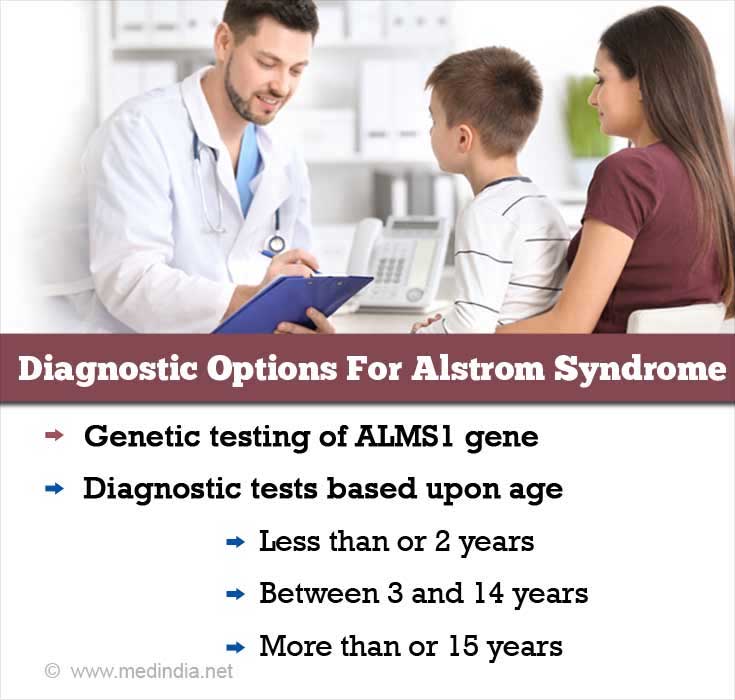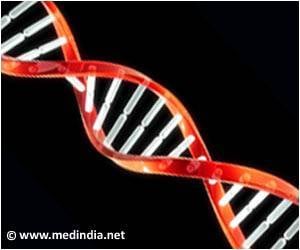- Marshall JD, Muller J, Collin GB, et al. Alström Syndrome: Mutation spectrum of ALMS1. Human mutation. 2015;36(7):660-668. doi:10.100.
- Regina M. Martin et al. Familial Hyperestrogenism in Both Sexes: Clinical, Hormonal, and Molecular Studies of Two Siblings, The J Clin Endocrinol & Metabol. 2003; Vol 88 (7):3027– 3034. - (https://doi.org/10.1210/jc.2002-021780)
- Marshall JD et al. Alström Syndrome: Genetics and Clinical Overview. Current Genomics. 2011;12(3):225-235. - (doi:10.2174/138920211795677912.)
- Marshall JD, Paisey RB, Carey C, et al. Alström Syndrome. 2003 Feb 7 [Updated 2012 May 31]. In: Adam MP, Ardinger HH, Pagon RA, et al., editors. GeneReviews® [Internet]. Seattle (WA): University of Washington, Seattle; 1993-2018.
- Alström syndrome. Updated Aug 31, 2016. Accessed Jun 11, 2018. Cited Jun 11, 2018. - (https://medlineplus.gov/ency/article/001665.htm)
- Alström syndrome. Updated Jun 15, 2016. Accessed Jun 11, 2018. Cited Jun 18, 2018. - (https://rarediseases.info.nih.gov/diseases/5787/alstrom-syndrome)
- Alström syndrome. Updated Jun 5, 2018. Accessed Jun 11, 2018. - (https://ghr.nlm.nih.gov/condition/alstrom-syndrome)
- Alström syndrome. Updated 2016. Accessed Jun 11, 2018. Cited Jun 18, 2018. - (https://rarediseases.org/rare-diseases/alstrom-syndrome/)
- Alstrom syndrome; ALMS. Updated April 20, 2016. Accessed Jun 11, 2018. Cited Jun 11, 2018 - (https://www.omim.org/entry/203800)
- Aromatase excess syndrome. Updated Jun 12, 2018. Accessed Jun 13, 2018, Cited Jun 13, 2018 - (https://ghr.nlm.nih.gov/condition/aromatase-excess-syndrome)
- Steatosis. Accessed Jun 13, 2018; Cited Jun 13, 2018. - (http://www.hepctrust.org.uk/information/impact-hepatitis-c-liver/steatosis)
- Day CP, James OFW. Steatohepatitis: A tale of two "hits"? Gastroenterol. 1998;114:842-845. - (https://www.gastrojournal.org/article/S0016-5085(98)70599-2/fulltext)
What is Alström Syndrome?
Alström syndrome (AS) is a rare genetic disorder that affects infants within the first year. The syndrome affects different functions of the body, such as vision (blindness), metabolism (obesity, liver disorder, diabetes, kidney problems), heart (cardiomyopathy), and hearing. Mutations in the ALMS1 gene cause Alström syndrome.
What are the causes of Alström Syndrome?
Alström syndrome is a genetic condition caused by the ALMS1 gene. Inheritance is autosomal recessive because both the genetic copies of ALMS1 need to be mutated to affect the individual. Hence, if the child inherits one mutated copy of ALMS1 from each parent, then the child is affected with Alström syndrome while the unaffected parents would be called carriers of the disease. To date, there are nearly 239 unique mutated sequences found in the ALMS1 gene.
What are the Symptoms and Signs of Alström Syndrome?
Degeneration of vision (cataracts, nystagmus, photophobia, and cone-rod dystrophy) is the first symptom observed in infants (80%-99%). Over the next 10 years, hearing deteriorates (sensorineural hearing loss - 80%-99%). Although height is unaffected in childhood, by adolescence and adulthood, growth rate decreases (80%-99%). Obesity develops in the initial years of life. Other symptoms are listed below:
- Dilated cardiomyopathy (DCM): May suddenly occur in the initial months of infancy
- Restrictive cardiomyopathy: Affects adults and adolescents
- Type 2 diabetes, hyperinsulinemia
- Hypothyroidism
- Polycystic ovaries in females
- Reduced testosterone levels in males (hypogonadism)
- Pulmonary fibrosis
- Acute respiratory distress syndrome (ARDS)
- Chronic obstructive pulmonary disorder (COPD)
- Seizures during fever
- Liver fibrosis or cirrhosis (hepatosplenomegaly, increased transaminases, steatohepatitis, steatosis)
- Fibrosis of multiple organs
- Reduced size of the penis
- Reflux in the gastrointestinal system
- Patches of dark skin (acanthosis nigricans) – Observed following insulin resistance
- Reduced height
- Increased fat levels within the blood (hyperlipidemia, hypertriglyceridemia)
- Renal disease (ESRD – End-stage renal disease in late stage adolescence)
- Kyphosis and scoliosis (bending and S-shape of the back) – initial teenage years
- Delayed motor development (coordination, sitting, balance, walking)
- Disturbed sleep
Normal intelligence is rarely affected in children with Alström syndrome.

How do you Diagnose Alström Syndrome?
Alström syndrome may be diagnosed based on the clinical symptoms, family history, and medical history of the individual. This is important when pregnant women undergo preimplantation genetic diagnosis or prenatal diagnosis. Amniocentesis or chorionic villus sampling is performed in prenatal diagnosis. Other relatives should be tested to see if they are carriers (having only one gene that is mutated but do not suffer from the disease.)
The symptoms of Alström syndrome vary among different individuals. There are certain diagnostic specifications based on age.
Less than or 2 years: Two major criteria – Family history of AS or mutation in one ALMS1 gene, vision defects (nystagmus; photophobia); or 1 major + 1 minor criteria (eg. obesity)
Between 3 and 14 years: Two major criteria (as listed above) – Vision defects also include cone dystrophy and reduced acuity; or 1 major + 3 minor criteria (hearing loss, kidney failure, increased bone age, obesity, irregular liver function)
More than or 15 years: Two major and two minor criteria or one major and three minor criteria. In addition to the above, vision defects include legal blindness; additional minor criteria, include irregular menses and/or excess male hormones in females; short height; absence or reduction of hormones in males.
Alström syndrome is diagnosed by genetically testing the ALMS1 gene when other diagnostic criteria fail to confirm the condition. Genetic testing is not required but helps to confirm diagnosis. Variants of the gene can be identified in nearly 40% of individuals in the world and more precisely in 70% - 80% of individuals with north-European ancestry.
Since different regions of the body are affected in this syndrome, there are specific tests to detect particular symptoms, e.g:
- Measurement of thyroid and pituitary hormones
- Hearing tests: Audiometry tests, conductive hearing loss
- Dilated cardiomyopathy: ECG and echocardiography along with precise cardiac history and examination
- Fasting lipid profile: Measurement of triglyceride levels
- Type 2 diabetes: Measurement of plasma insulin and fasting plasma glucose levels; glucose tolerance test
- Obesity: Measurement of BMI, height, and weight
- Cone-rod dystrophy: Evaluation of eyes, e.g. electroretinogram
- Liver disease: Ultrasonography, plasma enzyme concentration
- Lung disease: Lung function tests; chest radiography, CT scan
- Kidney disease: Renal function test, ultrasound, measurement of urea, creatinine, and electrolyte levels
- Neurological effects: EEG tests
- Urology: Kidney and bladder ultrasound

How is Alström Syndrome Treated?
Treatment is not specific to Alström syndrome but caters to each individual disorder that manifests in the syndrome.
Rod-cone dystrophy: Patients are slowly prepared to deal with blindness by learning to use Braille or other similar skills for the visually challenged. Red-tint prescription glasses help children see in bright light.
High blood sugar: Insulin-sensitizing drugs (eg. Thiazolidinediones and/or Metformin) although effective, could negatively affect the heart, kidneys, and liver. In certain cases, statins, nicotinic acid, and a low-fat diet help to alleviate the symptoms of Hypertriglyceridemia. Some children may require high doses of insulin for a prolonged period.
Cardiac tests: b-blockers, spironolactone, digitalis, diuretics are drugs used to treat cardiomyopathy. Prolonged inhibition of angiotensin-converting enzyme (ACE) is a recommended treatment for cardiomyopathy.
Self-catheterization: Bladder and urine flow are coordinated with self-catheterization.
Obesity: Exercise and reduction in weight are recommended.
Fatty liver: To reduce bleeding from small veins (varices), a transjugular intrahepatic portosystemic shunt is inserted. b-blockers and variceal banding help to treat portal hypertension and upper-GI (gastrointestinal) hemorrhage.
Thyroid function: Replacement therapy with hormone L-thyroxin is very effective.
Kidney function: Regular monitoring of kidneys is required. In some patients, kidney transplantation has worked. Your kidneys can be maintained with the help of ACE inhibitors.
Irregular menstruation: Estroprogestin and/or Metformin are used to treat irregular menses.
Regular vaccinations help to avoid hepatitis B and flu. More information and support is available on websites solely dedicated to the condition.
What is the Prognosis of Alström Syndrome?
Alström syndrome causes different complications, such as:
- Blindness
- Type 2 diabetes
- Loss of hearing
- Progressive liver and kidney failure
- Heart disease
If these conditions persist, death may also occur.








